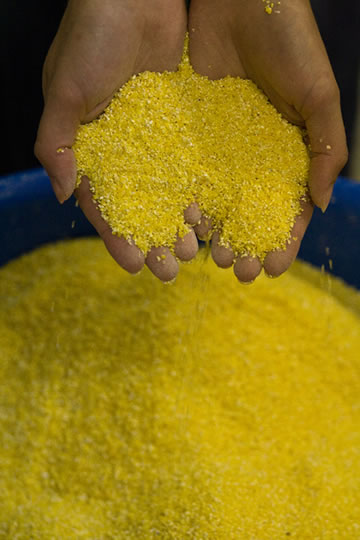|
 When
it comes to cornmeal selection, the decision isn't just yellow-and-white.
There's also blue. So which cornmeal should a home cook choose?
Studies show yellow cornmeal is more popular in Northern states,
while white cornmeal reigns in the South, but there aren't
any regional rules. Yellow cornmeal has a stronger flavor than white
cornmeal, and blue cornmeal has the slight antioxidant edge. Still,
the different colors can be used interchangeably. When
it comes to cornmeal selection, the decision isn't just yellow-and-white.
There's also blue. So which cornmeal should a home cook choose?
Studies show yellow cornmeal is more popular in Northern states,
while white cornmeal reigns in the South, but there aren't
any regional rules. Yellow cornmeal has a stronger flavor than white
cornmeal, and blue cornmeal has the slight antioxidant edge. Still,
the different colors can be used interchangeably.
Here, seven more facts that hold true for every
kind of cornmeal:
- Cornmeal has recently experienced a renaissance because it's
safe for eaters suffering from celiac disease or gluten intolerance.
Even for eaters without diagnosed medical conditions, though,
cornmeal consumption makes sense from a wellness perspective.
Cornmeal is rich in iron, phosphorus and dietary fiber, with as
many as 5 grams of fiber per 1/4-cup serving.
- Not surprisingly, the history of hot dogs dipped in cornmeal
batter is contentious. It's likely the preparation was pioneered
by German immigrants, who were in the habit of frying sausages
rolled in crushed bread. By 1929, a restaurant wholesaler was
pitching a dedicated oven for baking battered hot dogs; they were
supposed to emerge looking like corn. But the snack didn't
catch on with the public until Jack Karnis in 1941 hauled the
recipe back from an Oregon logging camp to the Minnesota State
Fair. Or maybe the corn dog's big break came the following
year, when Neil Fletcher started selling corny dogs at the State
Fair of Texas.
- According to "The Presidents' Cookbook," Calvin
Coolidge was a stickler for perfect cornmeal muffins. The White
House staff couldn't come up with a muffin that met Silent
Cal's expectations, so he asked a Northampton, Mass., innkeeper
to provide the recipe.
- Cornmeal is sold in three different textures: Fine (sometimes
labeled corn flour), medium and coarse. The medium-grind is most
common, but fine cornmeal is a good fit for soft muffins and spoonbreads.
Coarse cornmeal is typically reserved for polentas and grits.
Nowadays, most commercial cornmeal is processed through steel
rollers, but the traditional method called for a stone. Because
stone- or water-grinding leaves more hull and germ in the mix,
stone-ground cornmeal is considered more nutritious than its industrial
counterpart.
- Cuisines around the world now use cornmeal, which originated
as a staple of the Native American diet. It's baked into
roti in northern India, blended with okra cooking liquid for cou
cou in Barbados and cooked into thick porridge, or sadza, in Zimbabwe.
In northern China, conical steamed cornbread, or wotou, was elevated
from peasant food to an imperial dish after the Empress Dowager
Cixi subsisted on the snack while fleeing invaders in 1900.
- An Italian-Canadian club in Windsor, Ontario, last year set
the world record for producing the world's biggest polenta,
winning back the title from an Italian town. The unprecedented
polenta weighed just over 5 tons. "If it lumps up, we're
finished," the club president told a CBC reporter. "Once
you get lumps, forget it — you can throw everything away."
- Hoecakes probably didn't get their name from enslaved
laborers cooking the thin discs of batter on field tools. According
to a recent Slate story, "hoe" meant "griddle"
in 17th-century England. Hoecakes are one example of pone, the
simplest kind of cornbread and the most prevalent in the American
Colonies. British settlers weren't thrilled by cornmeal at
first: Food historian Betty Fussell writes that they thought of
cornmeal batter as "the sad paste of despair."
|




 When
it comes to cornmeal selection, the decision isn't just yellow-and-white.
There's also blue. So which cornmeal should a home cook choose?
Studies show yellow cornmeal is more popular in Northern states,
while white cornmeal reigns in the South, but there aren't
any regional rules. Yellow cornmeal has a stronger flavor than white
cornmeal, and blue cornmeal has the slight antioxidant edge. Still,
the different colors can be used interchangeably.
When
it comes to cornmeal selection, the decision isn't just yellow-and-white.
There's also blue. So which cornmeal should a home cook choose?
Studies show yellow cornmeal is more popular in Northern states,
while white cornmeal reigns in the South, but there aren't
any regional rules. Yellow cornmeal has a stronger flavor than white
cornmeal, and blue cornmeal has the slight antioxidant edge. Still,
the different colors can be used interchangeably.